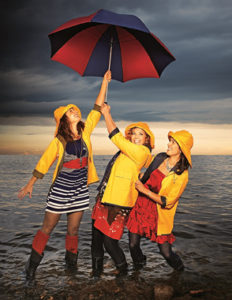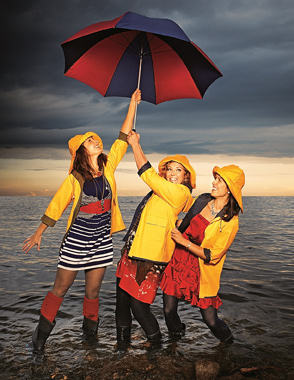John Nyman
Arts Editor
Toronto may not love folk music – at least generally – but the Good Lovelies are one folk group who love Toronto. The trio’s new album, Let the Rain Fall, combines an upbeat collection of folk sounds with the sass of Toronto life in a unique and overwhelmingly smile-inducing package.

The Good Lovelies’ music brings in everything you would expect from a vocally oriented folk trio, but with an especially cute flair. Guitar, mandolin, piano and upright bass bring out simple, catchy rhythms, and accompany perfect three-part harmonies. Beyond this formula, everything about Let the Rain Fall, from the album’s cover art and photography to its lyrics to its unbelievably bright vocals, is cheery and almost – but not quite – sickeningly positive.
“We want everyone to have a good time,” said Good Lovelies member Sue Passmore, who sings with fellow Lovelies Caroline Brooks and Kerri Ough on the first track, “Let the rain fall, soak us to the bone, nothing will sink our smiles.”
Despite the cuteness of their image and artistic aims, Passmore, Brooks and Ough know what they’re doing musically. All three of the Good Lovelies performed solo folk acts during and after university, with Passmore getting her start playing gigs at the Absinthe Pub while studying at York University. Once they formed their band, they decided to add instruments like mandolins and upright bass to their repertoire.
The early days of the Good Lovelies are also where the trio learned the power of their harmonies. During a show where each performed their solo act, the three decided to try singing together, and the Lovelies started taking shape.
“It was so easy to sing harmonies together,” Passmore said, describing how the band and their characteristic sound emerged. Fans and critics often compare the Good Lovelies to the Andrews Sisters because of the clarity and pitch-perfection of their harmonies, though Passmore notes the effect was not something they sought; the Good Lovelies’ harmonies happened naturally.
In fact, the Lovelies are distinguished by a variety of musical influences. Brooks, whose father was a guitar teacher, grew up in a musical household heavily steeped in the folk tradition. Ough’s favourite musicians span a range of popular genres, while Passmore was first directed toward vocals by her love of jazz; originally, she wanted to be a jazz singer.
While the tone and instrumentation of Let the Rain Fall is refreshingly consistent, the album also isn’t afraid to bring these diverse influences into play with a variety of different songs. The album shines most brightly in upbeat tracks such as “Made for Rain,” “Free” and “Backyard,” but slower songs like the bittersweet “Lonesome Hearts,” with its tin pan brass accompaniment, keep the album at a solid pace. Other elements that add to the mix include the classic refrain of “Oh, What A Thing,” the engaging ballad style of “Mrs. T” and an amazing cover of k-os’ “Crabbuckit.”
“Backyard” may be the album’s most original and attention-getting song. Described by Passmore as “a love song for Toronto,” written by Brooks to acknowledge the faults of the city she loves, the song mentions Toronto’s pollution, noise and even “a crazy lady slurring words.” While all of Let the Rain Fall’s lyrics are thoughtfully written, “Backyard” seems to be the most aware of the inherent weirdness of trying to live a carefree folk lifestyle in a contemporary urban environment.
Along these lines, Let the Rain Fall’s references to the urban jungle may be part of a trend in contemporary folk music – especially in the Toronto scene – that sets it apart from its roots.

“What’s labelled under folk right now is not quite the same as traditional folk,” said Passmore.
Regardless of where the genre is going, Passmore considers Toronto an ideal central location for the Good Lovelies’ musical development. She and her bandmates have come into contact with many folk artists passing through Hugh’s Room, the city’s main venue for folk music, though she laments Toronto doesn’t have a major music festival catering to the genre.
Even closer to home, Passmore remembers York as a great place to find inspiration and make connections within the music and fine arts communities. She even met the Good Lovelies’ producer, Adam King, while studying here.
“York was a really great place for me to get going and get started,” she said. “It was a really great spot for making things happen outside the classroom.”
The Good Lovelies’ third full-length album
Release Date: February 22, 2011
Release Party: April 2, 2011 at the Great Hall
Good Lovelies, great Toronto folk


